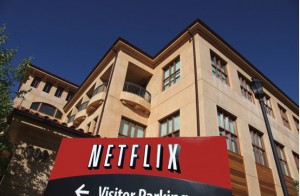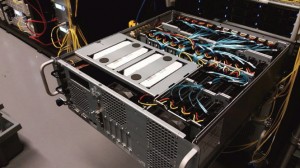HGST Helium-Filled HDD Take Netflix Capacity
Accommodating data growth of video streaming service
This is a Press Release edited by StorageNewsletter.com on September 29, 2014 at 2:50 pmThe way people consume video-based content has changed dramatically over recent years.
Netflix Corporate Headquarters
At the forefront of this evolution is Netflix Inc., today’s video-streaming service. It’s difficult to find a current generation TV, gaming console or digital streaming device this isn’t ‘Netflix-ready’. The company has experienced growth since launching its video-streaming service in 2007. Based on recent expansion efforts, there seems to be no end in sight to consumers’ growing appetites for on-demand video. Consider these stats:
-
Netflix serves over one-billion hours per month of movies and TV shows, streaming them to more than 48 million viewers in 41 countries.
-
The company has differentiated itself from competitive offerings with content, such as Arrested Development, House of Cards and Orange Is the New Black.
-
During prime time, Netflix is estimated to consume one-third of consumer-based Internet traffic.
So how does Netflix continue to fuel its rocket-like growth trajectory?
The company has built out its own content delivery network to ensure it can meet customer needs and expectations for anentertainment experience.
According to David Fullagar, director content delivery architecture, Netflix, the company faces technological challenges. “Allowing people to watch what they’d like to watch, when they’d like to watch it, on essentially any connected device has proven to be a big hit with consumers,” he said. “We serve up incredible amounts of data at any time of day and we continue to push the envelope. Today, the best quality video, including Ultra HD 4K, is only available through the internet where Netflix is the innovation leader. This digital content must be ready for delivery, on-demand, to more than 48 million Netflix customers, placing incredible pressure on the content delivery infrastructure.“
In 2011, Netflix was using the three largest third-party content delivery networks and was a large consumer of each of those services.
“We decided to build our own infrastructure and maintain a direct relationship with those ISPs to help solve their issues of scaling our traffic,” said Fullagar.
Taking World by Storm: Natural Disasters and Global Supply
Chain Streaming a petabyte of video content to millions of users around the world requires highly specialized equipment. Netflix began customdesigning its own Open Connect content delivery hardware to handle its massive streaming demands. As the company undertook this ambitious effort, Mother Nature had other plans.
The interdependence of the global supply chains and the resolve of storage companies and customers was tested as never before in the aftermath of the powerful earthquake and tsunami off the east coast of Japan in March 2011, followed by severe flash flooding in Thailand in November that same year. These disasters left interdependent supply chains broken as many HDD providers’ just-in-time delivery models seized up when memory component manufacturing and deliveries were disrupted.
However, HGST Inc. had chosen to build inventory buffers as a response to rapid changes in market demand. “The flooding caused significant supply chain issues in the market,” recalled Fullagar. “We began working directly with HGST to shore up confidence with our storage supply chain and have maintained a good relationship with them ever since.“
The Netflix team began designing and building the highest-capacity video streaming appliances possible using HGST 3TB Ultrastar HDDs. As 4TB Ultrastar drives became available, Netflix embraced them, instantly increasing capacity by 33%. In the meantime, HGST worked with suppliers and employees in affected countries to help restore their livelihood and bring production facilities online.
Netflix video streaming appliance with 36x6TB HGST HDD
The Ultrastar He6: New Milestone in Storage Innovation
On November 4, 2013, HGST took HDD capacity and TCO to a new level by launching its revolutionary Ultrastar He6 HelioSeal-drive storage platform. This engineering breakthrough was the first HDD technology to increase capacity while lowering both power consumption and drive temperature at the same time, and in a standard 3.5-inch HDD footprint. As a result, it offers today’s best watt-per-terabyte, terabyte-per-system weight, and terabyte-per-square foot.
The Ultrastar He6 drive is hermetically sealed using HelioSeal technology platform. At one-seventh the density of air, helium reduces the turbulence caused by the spinning disk, cuts power consumption and lowers temperature within the disk drive. With a close working relationship with HGST, Netflix began testing the Ultrastar He6 drives in October 2013 – several weeks prior to the product launch and general product availability. During a six-week trial, Fullagar and his team validated the performance, reliability and power efficiency claims of the helium-filled drives, then quickly began buying the He6 drives in volume.
Taking Performance and Value to Next Level
“We’ve been very happy with HGST drives,” Fullagar stated. “In fact, the only reason we moved from the 3TB to the 4TB drives, and now to the 6TB Helium drives, is because HGST is a capacity leader and continues to deliver greater value in terms of TCO.”
Compared to a 3.5-inch, five-platter, air-filled 4TB drive, HGST’s seven-platter Ultrastar 3.5-inch He6 Helium drives deliver the following advantages:
-
6TB capacity, providing lowest TCO on the market
-
Lowest power consumption with best watts-per-terabyte
-
23% lower idle power per drive
-
49% reduction in watts-per-terabyte
-
-
Best density footprint in a standard 3.5-inch form factor
-
50%t higher capacity
-
-
Lighter weight than a standard five-disk 3.5-inch drive
-
50g lighter, even with two more disks
-
38% lower weight-per-terabyte
-
“Because of the nature of our on-demand streaming service, storage consumes more than two-thirds of our power budget,” Fullagar said. “We’re saving about 90 watts per appliance. This saving is very significant when you’re talking about thousands of streaming applicances.“
Reliability No Longer an Issue
In addition to storage density, space and power efficiency, the Netflix Open Connect delivery platform places a premium on reliability.
“HDDs and cooling fans are the only mechanical components in our systems,” Fullagar stated. “Having high reliability in the HDD means there are fewer failures we need to deal with. This reliability is very important to us because we don’t plan to do any field maintenance on our servers.“
How does Fullagar sum up his relationship with HGST? “We continue to receive excellent technical, sales and logistical support from HGST,” he said. “When you get to our scale and level of technical maturity, this level of support and collaborative relationship becomes essential.“














 Subscribe to our free daily newsletter
Subscribe to our free daily newsletter
